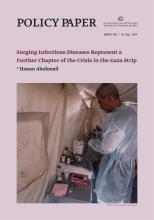Parts of Gaza are at high risk of famine according to a new report released today, which classified 378,000 people as facing “catastrophic levels of acute food insecurity.”
Parts of Gaza are at high risk of famine according to a new report released today, which classified 378,000 people as facing “catastrophic levels of acute food insecurity.”
This includes Action Against Hunger, which has distributed 5,200 liters of drinking water and food in Gaza City and provided cash assistance through existing financial service providers.
The end of the ceasefire and the resumption of Israel's bombing of Gaza had jeopardized humanitarian efforts in the besieged enclave, Action Against Hunger warned, adding that canned food was scarce in local markets while concerns were rising as the vegetable harvest faced imminent depletion.
Jean-Raphael Poitou, of Action Against Hunger, told AFP that "solar panels and generators, for instance "are included in the banned list of "dual-use" items. "It's the sort of thing we need to be able to meet needs in Gaza more efficiently," he said.
Before the war, cases of acute malnutrition like those being recorded today were non-existent, international NGO Action Against Hunger noted in a recent report on conflict-induced hunger in Gaza. Jack Seal, communications officer at Action Against Hunger, explained to The New Arab that a state of famine can only be declared when certain criteria is met.
The World Food Program has estimated that each person in northern Gaza has access to an average of 1.8 liters of safe drinking water per day, while in the south, it is 2 liters. “(The) human body cannot survive with such a small quantity of water,” said Saccardi of Action Against Hunger.
Gaza is facing a “catastrophic” hunger crisis of unprecedented proportions, according to the UN, with everyone in the besieged coastal strip liable to face acute food insecurity in the coming weeks.
“The lack of water and hygiene is aggravating the diseases: diarrhea, vomiting, skin allergy, lice in the children’s hair,” said Chiara Saccardi, regional head of Action Against Hunger. During last month’s temporary pause in fighting, the World Food Program conducted a rapid food assessment, which it released on Wednesday, concluding that the situation in Gaza was “alarming.”
People do not have access to food and water. The healthcare system has collapsed, attacks on hospitals have left much of Gaza’s population without access to any treatment. The outbreak of disease is threatening lives further. We need to reach people now.
Action Against Hunger is gravely concerned by the declaration made in a new UN-led report, classifying hunger levels in areas of northern Gaza and for thousands of internally displaced people in the south as Level 5, or “catastrophic” – signifying a very high risk of famine.
Israel launched a new assault against the Palestinian people in the Gaza Strip which began officially on October 7, 2023. In this assault, Israel's occupation army, with full political coverage, targeted all infrastructure installations in Gaza, especially the health sector which was singled out in a systematic and unprecedented manner, indicating the existence of a preconceived Israeli plan to destroy the heath infrastructure in the northern part of the Strip to make it unlivable and to drive its population southwards (the plan had originally envisaged their expulsion to Egypt but when this fell through it was decided to drive that population to central and southern Gaza). This deliberate and systematic targeting campaign vented itself in the indiscriminate bombing of urban quarters and high-rise residential towers in order to butcher the largest number of civilians and to systematically destroy all health facilities, with a view to forcing the population to head southwards where health facilities and medical emergency services had already far exceeded their absorption capacities. Read more
المصادر:
المصادر:
المصادر:
المصادر:
